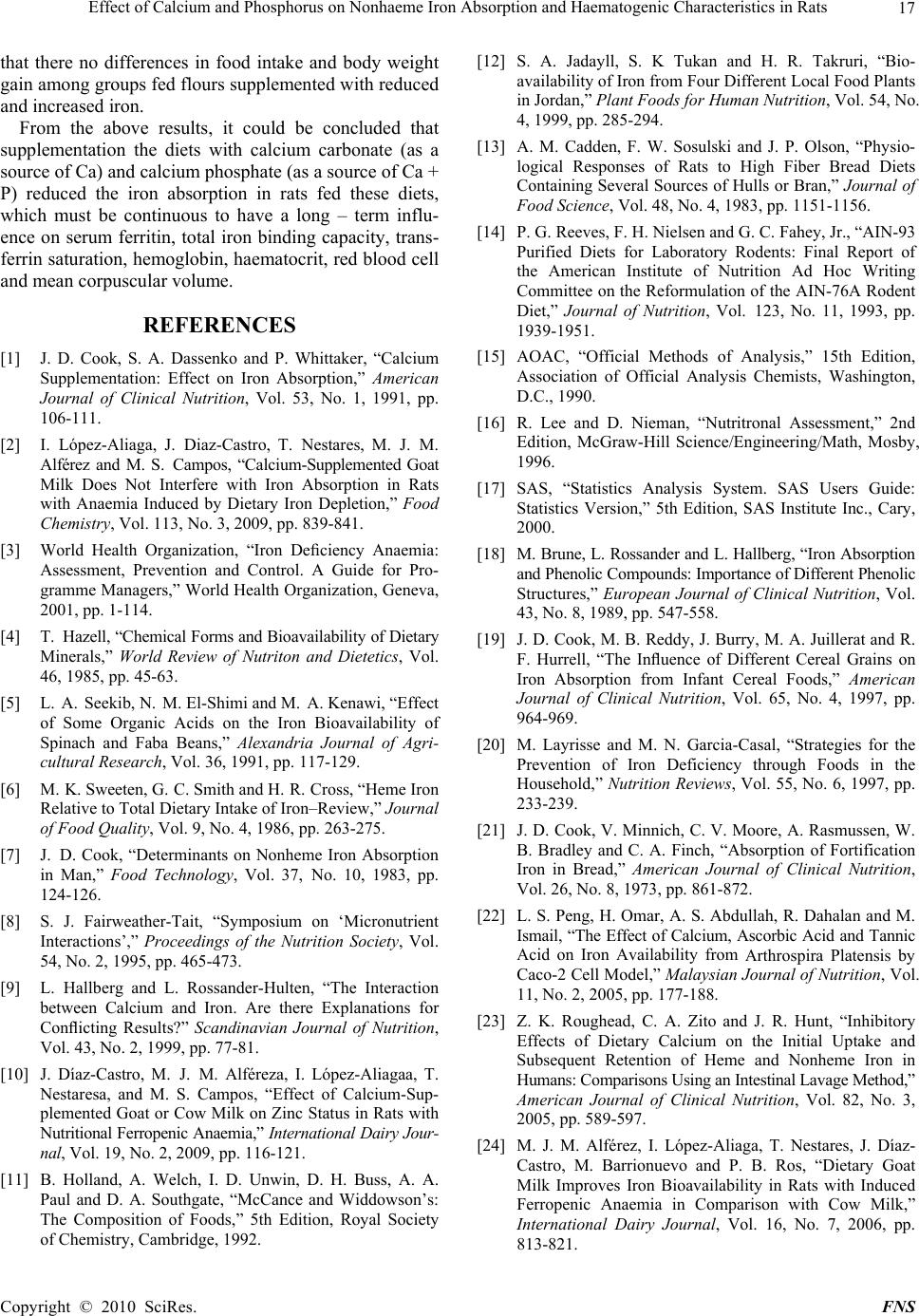
Effect of Calcium and Phosphorus on Nonhaeme Iron Absorption and Haematogenic Characteristics in Rats 17
that there no differences in food intake and body weight
gain among groups fed flours supplemented with reduced
and increased iron.
From the above results, it could be concluded that
supplementation the diets with calcium carbonate (as a
source of Ca) and calcium phosphate (as a source of Ca +
P) reduced the iron absorption in rats fed these diets,
which must be continuous to have a long – term influ-
ence on serum ferritin, total iron binding capacity, trans-
ferrin saturation, hemoglobin, haematocrit, red blood cell
and mean corpuscular volume.
REFERENCES
[1] J. D. Cook, S. A. Dassenko and P. Whittaker, “Calcium
Supplementation: Effect on Iron Absorption,” American
Journal of Clinical Nutrition, Vol. 53, No. 1, 1991, pp.
106-111.
[2] I. Lόpez-Aliaga, J. Diaz-Castro, T. Nestares, M. J. M.
Alférez and M. S. Campos, “Calcium-Supplemented Goat
Milk Does Not Interfere with Iron Absorption in Rats
with Anaemia Induced by Dietary Iron Depletion,” Food
Chemistry, Vol. 113, No. 3, 2009, pp. 839-841.
[3] World Health Organization, “Iron Deficiency Anaemia:
Assessment, Prevention and Control. A Guide for Pro-
gramme Managers,” World Health Organization, Geneva,
2001, pp. 1-114.
[4] T. Hazell, “Chemical Forms and Bioavailability of Dietary
Minerals,” World Review of Nutriton and Dietetics, Vol.
46, 1985, pp. 45-63.
[5] L. A. Seekib, N. M. El-Shimi and M. A. Kenawi, “Effect
of Some Organic Acids on the Iron Bioavailability of
Spinach and Faba Beans,” Alexandria Journal of Agri-
cultural Research, Vol. 36, 1991, pp. 117-129.
[6] M. K. Sweeten, G. C. Smith and H. R. Cross, “Heme Iron
Relative to Total Dietary Intake of Iron–Review,” Journal
of Food Quality, Vol. 9, No. 4, 1986, pp. 263-275.
[7] J. D. Cook, “Determinants on Nonheme Iron Absorption
in Man,” Food Technology, Vol. 37, No. 10, 1983, pp.
124-126.
[8] S. J. Fairweather-Tait, “Symposium on ‘Micronutrient
Interactions’,” Proceedings of the Nutrition Society, Vol.
54, No. 2, 1995, pp. 465-473.
[9] L. Hallberg and L. Rossander-Hulten, “The Interaction
between Calcium and Iron. Are there Explanations for
Conflicting Results?” Scandinavian Journal of Nutrition,
Vol. 43, No. 2, 1999, pp. 77-81.
[10] J. Díaz-Castro, M. J. M. Alféreza, I. López-Aliagaa, T.
Nestaresa, and M. S. Campos, “Effect of Calcium-Sup-
plemented Goat or Cow Milk on Zinc Status in Rats with
Nutritional Ferropenic Anaemia,” Internati onal Dairy Jour-
nal, Vol. 19, No. 2, 2009, pp. 116-121.
[11] B. Holland, A. Welch, I. D. Unwin, D. H. Buss, A. A.
Paul and D. A. Southgate, “McCance and Widdowson’s:
The Composition of Foods,” 5th Edition, Royal Society
of Chemistry, Cambridge, 1992.
[12] S. A. Jadayll, S. K Tukan and H. R. Takruri, “Bio-
availability of Iron from Four Different Local Food Plants
in Jordan,” Plant Foods for Human Nutrition, Vol. 54, No.
4, 1999, pp. 285-294.
[13] A. M. Cadden, F. W. Sosulski and J. P. Olson, “Physio-
logical Responses of Rats to High Fiber Bread Diets
Containing Several Sources of Hulls or Bran,” Journal of
Food Science, Vol. 48, No. 4, 1983, pp. 1151-1156.
[14] P. G. Reeves, F. H. Nielsen and G. C. Fahey, Jr., “AIN-93
Purified Diets for Laboratory Rodents: Final Report of
the American Institute of Nutrition Ad Hoc Writing
Committee on the Reformulation of the AIN-76A Rodent
Diet,” Journal of Nutrition, Vol. 123, No. 11, 1993, pp.
1939-1951.
[15] AOAC, “Official Methods of Analysis,” 15th Edition,
Association of Official Analysis Chemists, Washington,
D.C., 1990.
[16] R. Lee and D. Nieman, “Nutritronal Assessment,” 2nd
Edition, McGraw-Hill Science/Engineering/Math, Mosby,
1996.
[17] SAS, “Statistics Analysis System. SAS Users Guide:
Statistics Version,” 5th Edition, SAS Institute Inc., Cary,
2000.
[18] M. Brune, L. Rossander and L. Hallberg, “Iron Absorption
and Phenolic Compounds: Importance of Different Phenolic
Structures,” European Journal of Clinical Nutrition, Vol.
43, No. 8, 1989, pp. 547-558.
[19] J. D. Cook, M. B. Reddy, J. Burry, M. A. Juillerat and R.
F. Hurrell, “The Influence of Different Cereal Grains on
Iron Absorption from Infant Cereal Foods,” American
Journal of Clinical Nutrition, Vol. 65, No. 4, 1997, pp.
964-969.
[20] M. Layrisse and M. N. Garcia-Casal, “Strategies for the
Prevention of Iron Deficiency through Foods in the
Household,” Nutrition Reviews, Vol. 55, No. 6, 1997, pp.
233-239.
[21] J. D. Cook, V. Minnich, C. V. Moore, A. Rasmussen, W.
B. Bradley and C. A. Finch, “Absorption of Fortification
Iron in Bread,” American Journal of Clinical Nutrition,
Vol. 26, No. 8, 1973, pp. 861-872.
[22] L. S. Peng, H. Omar, A. S. Abdullah, R. Dahalan and M.
Ismail, “The Effect of Calcium, Ascorbic Acid and Tannic
Acid on Iron Availability from Arthrospira Platensis by
Caco-2 Cell Model,” Malaysian Journal of Nutrition, Vol.
11, No. 2, 2005, pp. 177-188.
[23] Z. K. Roughead, C. A. Zito and J. R. Hunt, “Inhibitory
Effects of Dietary Calcium on the Initial Uptake and
Subsequent Retention of Heme and Nonheme Iron in
Humans: Comparisons Using an Intestinal Lavage Method,”
American Journal of Clinical Nutrition, Vol. 82, No. 3,
2005, pp. 589-597.
[24] M. J. M. Alférez, I. López-Aliaga, T. Nestares, J. Díaz-
Castro, M. Barrionuevo and P. B. Ros, “Dietary Goat
Milk Improves Iron Bioavailability in Rats with Induced
Ferropenic Anaemia in Comparison with Cow Milk,”
International Dairy Journal, Vol. 16, No. 7, 2006, pp.
813-821.
Copyright © 2010 SciRes. FNS